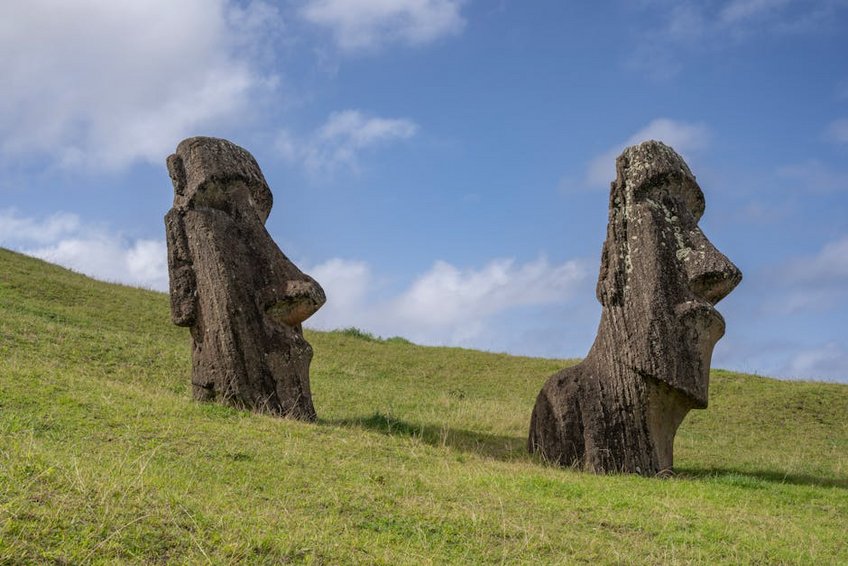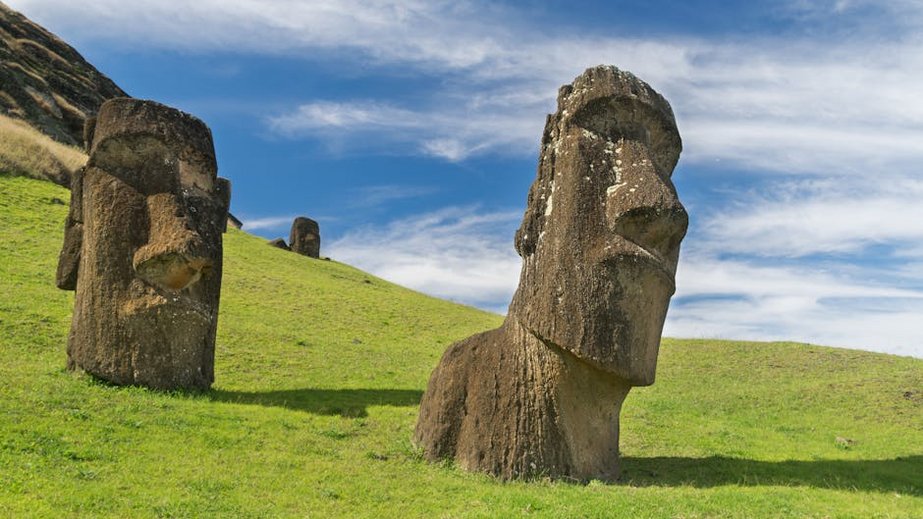Chile Easter Island Moai Statues: Unraveling the Ancient Mysteries
Standing tall against the Pacific winds, the Chile Easter Island Moai statues represent one of the world’s most fascinating archaeological wonders that continue to captivate travelers and historians alike. These monumental stone figures, carved by the Rapa Nui people between 1250 and 1500 CE, create an atmosphere of mystery and awe that you simply must experience firsthand. Located in one of the most remote inhabited islands on Earth, Easter Island (or Rapa Nui) offers a unique blend of Polynesian culture, dramatic landscapes, and these iconic stone guardians watching over the coastline. As you plan your journey to this UNESCO World Heritage site, you’ll discover that each Moai has its own story, with some standing proudly on ceremonial platforms called ahu while others lie partially carved in the Rano Raraku quarry. The Chile Easter Island Moai statues experience isn’t just about seeing stone figures; it’s about connecting with an ancient civilization that mastered stone carving and transportation techniques that still puzzle archaeologists today. Whether you’re drawn by the mystery, the photography opportunities, or the cultural significance, visiting these statues promises to be a transformative travel experience that will stay with you long after you return home.
Chile Easter Island Moai Statues – Essential Information
Before embarking on your adventure to see the Chile Easter Island Moai statues, understanding their historical and cultural context will significantly enhance your experience. These monumental figures average 13 feet tall and weigh approximately 14 tons, though the largest unfinished Moai measures over 69 feet and weighs an estimated 270 tons. The statues were carved from compressed volcanic ash found at the Rano Raraku quarry using basalt stone tools called toki, and they originally featured coral and red scoria eyes that were only inserted during special ceremonies. What makes the Chile Easter Island Moai statues particularly fascinating is that they’re not just random sculptures; each one represents a deified ancestor who watched over the island’s clans and villages. As you explore different sites, you’ll notice variations in size, style, and preservation that reflect the island’s complex social history and the eventual decline of Moai construction. Understanding these details will help you appreciate why this remote island continues to draw curious travelers from around the world seeking to unravel its ancient secrets.
What Are the Moai Statues? – Key Characteristics
- The statues typically feature prominent foreheads, long ears, strong noses, and thin lips, with some wearing pukao (topknots) made of red scoria stone
- Most Moai face inland rather than toward the ocean, watching over their descendants, except for the seven statues at Ahu Akivi which face the sea
- Archaeological evidence suggests the statues were transported using a combination of log rollers, ropes, and human power across the island’s terrain
- Budget travelers can manage with $70-100 USD per day by staying in hostels, cooking some meals, and using bicycle rentals to explore Moai sites independently
- Mid-range visitors typically spend $150-250 USD daily for comfortable hotels, restaurant meals, guided tours to key statues, and rental cars for flexibility
- Luxury experiences range from $300-500+ USD per day featuring upscale eco-lodges, private guides, fine dining, and special access to restricted archaeological sites
- Rapa Nui Tourism Board Official Site
- Lonely Planet Easter Island Guide
Historical Significance and Cultural Context
The Chile Easter Island Moai statues represent one of humanity’s most remarkable cultural achievements, created by a Polynesian society that sailed thousands of miles across the Pacific. Between the 13th and 16th centuries, the Rapa Nui people developed a complex society organized around clan lineages, with each clan carving and erecting Moai to honor ancestors and demonstrate power. The construction peaked around 1400-1600 CE, after which environmental degradation, deforestation, and social conflicts led to the collapse of this tradition. By the time European explorers arrived in 1722, many statues had been toppled during internal conflicts, and the population had declined significantly. Today, the descendants of the original sculptors continue to preserve and celebrate this heritage, with ongoing restoration projects helping to re-erect some of the fallen giants. This rich history adds profound meaning to your visit, transforming it from mere sightseeing to a genuine cultural immersion.
Chile Easter Island Moai Statues – Planning Your Trip
Planning your journey to witness the Chile Easter Island Moai statues requires careful consideration of timing, budget, and preparation due to the island’s remote location and unique challenges. Easter Island sits approximately 2,300 miles west of Chile’s mainland, making it one of the most isolated inhabited islands globally, which significantly impacts travel logistics and costs. You’ll need to account for flight availability, accommodation options ranging from basic hostels to luxury eco-lodges, and the fact that most services operate on “island time” with a more relaxed pace than mainland Chile. The Rapa Nui National Park, which encompasses most Moai sites, requires an entrance ticket that costs around $80 USD for international visitors, valid for ten days. Additionally, you should plan your itinerary to include key sites like Rano Raraku quarry, Ahu Tongariki, and Anakena Beach while allowing flexibility for weather changes and spontaneous discoveries. Proper planning ensures you maximize your experience while respecting the island’s fragile ecosystem and cultural significance.
Best Time to Visit Easter Island
Determining the ideal time for your Chile Easter Island Moai statues adventure depends largely on your preferences for weather, crowds, and cultural events. The island enjoys a subtropical climate with relatively stable temperatures year-round, averaging 73°F (23°C), but rainfall patterns vary significantly. For optimal conditions, visit during the shoulder seasons of September-November or March-May when temperatures are pleasant, rainfall is lower, and tourist numbers are moderate. The summer months of December-February bring warmer weather but also higher humidity, more rainfall, and peak tourist crowds that can make popular Moai sites quite busy. If you’re interested in cultural experiences, consider timing your visit with the Tapati Festival in late January to early February, when the island comes alive with traditional competitions, dances, and ceremonies. Winter months (June-August) offer cooler temperatures and fewer visitors but stronger winds that might affect some outdoor activities. Regardless of when you visit, always pack layers and waterproof gear as weather can change rapidly.
Budget Planning and Costs
Essential Preparation Checklist
Preparing adequately for your Chile Easter Island Moai statues journey ensures a smoother and more enjoyable experience on this remote island. First, verify your passport validity and check visa requirements, as US and EU passport holders typically receive a 90-day tourist card upon arrival. Book flights well in advance since LAT Airlines operates the only regular commercial flights from Santiago, Chile, and prices fluctuate significantly. Pack versatile clothing including lightweight layers, rain jacket, sturdy walking shoes, sun protection (hat, sunscreen, sunglasses), and a reusable water bottle since tap water isn’t drinkable. Download offline maps and translation apps since internet connectivity can be unreliable outside Hanga Roa, the main town. Exchange some Chilean pesos before arrival as ATMs are limited, though credit cards are widely accepted. Finally, research basic Rapa Nui phrases and cultural etiquette to show respect for local traditions during your Moai explorations.

Chile Easter Island Moai Statues – Top Attractions and Activities
Exploring the various Chile Easter Island Moai statues sites reveals different aspects of Rapa Nui culture and provides unforgettable photographic opportunities. While the island measures just 63 square miles, it hosts nearly 900 Moai statues at various stages of completion, from fully erected figures to those abandoned in quarries. Your itinerary should balance the famous sites with lesser-known locations to appreciate the full scope of this archaeological treasure. Start with Ahu Tongariki, the largest ceremonial platform with 15 restored Moai standing dramatically against the sunrise, then visit Rano Raraku quarry where nearly 400 statues remain in various states of carving. Don’t miss the unique kneeling Moai at Ahu Huri a Urenga or the solitary figure at Ahu Ature Huki, which was the first Moai successfully re-erected using traditional methods in modern times. Beyond the statues themselves, consider adding cultural activities like traditional dance performances, petroglyph viewings, and workshops on Rapa Nui crafts to deepen your understanding of the people who created these marvels.
Must-See Highlights
Your Chile Easter Island Moai statues tour wouldn’t be complete without visiting these essential sites that showcase the diversity and grandeur of Rapa Nui’s stone legacy. Ahu Tongariki presents the most impressive collection with 15 massive Moai perfectly aligned on a 200-foot-long platform, especially magical at sunrise when the statues create dramatic silhouettes against the morning sky. The Rano Raraku quarry offers a fascinating glimpse into the carving process, with nearly 400 statues in various stages of completion scattered across the hillside, including the giant El Gigante measuring 72 feet tall. At Ahu Nau Nau on Anakena Beach, you’ll find some of the best-preserved Moai with detailed facial features and their original pukao (topknots), set against one of the island’s few sandy beaches perfect for a refreshing swim. The seven Moai at Ahu Akivi are unique for facing the ocean rather than inland, representing the seven explorers sent by legendary King Hotu Matu’a according to oral tradition. Each site tells a different chapter in the island’s history, making them essential stops on your Moai exploration journey.
Hidden Gems and Local Favorites
Beyond the famous sites, discovering lesser-known Chile Easter Island Moai statues locations provides a more intimate experience and helps distribute tourism impact across the island. Ahu Hanga Kio’e features a single restored Moai on a remote coastal platform with stunning ocean views and far fewer visitors than popular sites. The inland site Ahu Huri a Urenga contains a unique Moai with two pairs of hands and astronomical alignment, believed to mark the winter solstice. For adventurous travelers, the Poike peninsula hosts several toppled Moai in dramatic coastal settings accessible via hiking trails with breathtaking vistas. Local guides often recommend visiting Ahu Vinapu to admire the precise stonework resembling Inca architecture, sparking theories about pre-Columbian transoceanic contact. Don’t overlook the museum in Hanga Roa, which provides essential context about Moai creation and transportation before you explore the sites. These hidden gems offer quieter moments of contemplation and photography away from the main tourist routes.
Chile Easter Island Moai Statues – Practical Travel Information
Navigating the practical aspects of visiting the Chile Easter Island Moai statues ensures a comfortable and efficient trip to this remote destination. The island has limited infrastructure compared to mainland Chile, so advance planning for transportation, accommodation, and services is crucial. Most visitors fly from Santiago (5.5 hours) or Tahiti (weekly flights), with LAT Airlines being the primary carrier, so booking flights several months in advance secures better prices. Upon arrival, you’ll find that Hanga Roa serves as the main hub with restaurants, shops, and services, while the rest of the island remains largely undeveloped with gravel roads connecting archaeological sites. The Rapa Nui National Park entry ticket ($80 USD) is required for visiting all major Moai sites and can be purchased at the airport or park offices. Mobile coverage exists in Hanga Roa but becomes spotty elsewhere, so downloading offline resources beforehand is wise. With proper preparation, you can focus entirely on absorbing the magical atmosphere of these ancient stone guardians.
| Category | Options/Features | Price Range (USD) |
|---|---|---|
| Accommodation | Hostels, mid-range hotels, luxury eco-lodges with ocean views | $40-500 per night |
| Transportation | Bicycle rentals, scooters, cars, guided tours with transportation | $15-120 per day |
| Food & Dining | Local markets, casual restaurants, upscale dining featuring fresh seafood | $10-80 per meal |


